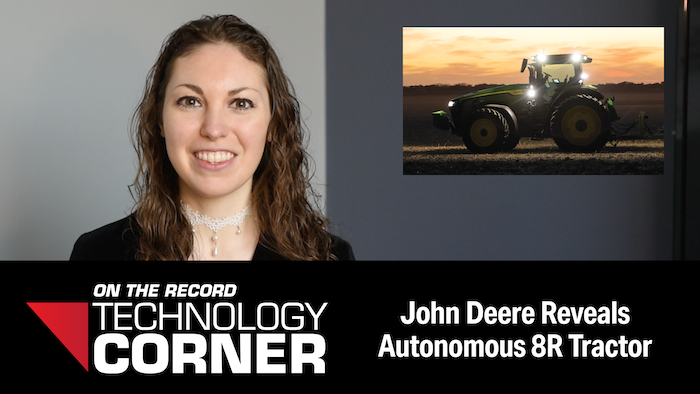Autonomy has gone mainstream with John Deere’s announcement that it has a fully autonomous tractor ready for large-scale production.
John Deere revealed the fully autonomous tractor at CES 2022 in early January and says the machine will be available to farmers in time for fall 2022 tillage operations.
The machine combines Deere’s 8R tractor, TruSet-enabled chisel plow, GPS guidance system and other new technologies. The technology comes from John Deere and Blue River, an artificial intelligence developer acquired by Deere in 2017.
The 40,000-pound autonomous tractor uses six pairs of stereo cameras for 360-degree obstacle detection. Images captured by the cameras go through a neural network that classifies each pixel in approximately 100 milliseconds and determines if the machine continues to move or stops, depending on if an obstacle is detected.
Willy Pell, vice president of autonomy and new ventures at Deere, says the machine was trained on 50 million images from farms across the U.S., and it’s continually fed images and rewarded for making the right decision to further improve its accuracy.
To handle novel obstacles while working in the field, Pell says Deere’s engineers built an anomaly detection system, which recognizes sky, ground and trees. When the tractor encounters an object that doesn’t fit in those classes, it stops.
“Using this technology, we’re able to achieve a very high degree of safety and performance, despite situations where the autonomous tractor sees a completely new or random object,” Pell says.
‘Secret Sauce’ of Autonomous 8R Tractor
Mig Dobre, senior research analyst at R.W. Baird, says the Blue River algorithm is the “secret sauce” to the autonomous tractor.
“[W]e believe this presents Deere with a unique solution and advantage which other OEMs will find very difficult to replicate,” Dobre writes.
Scott Shearer, chair of the department of food, agricultural and biological engineering at Ohio State University, says Deere’s acquisition of Blue River and, more recently, Bear Flag Robotics indicated the company was moving in the direction of autonomous equipment. He was surprised by the timing of the announcement but notes another big move in the industry recently — CNH Industrial’s purchase of Raven at the end of 2021.
“In general, we have manufacturers moving away from historically their role as an iron company into being a technology company,” Shearer says.
Slow Rollout Expected
To use the machine, the farmer must transport it to a field and start autonomous operation using the John Deere Operations Center app on their phone or tablet. The tractor will beep if the area is clear and start operating. The farmer can then move onto other tasks while still monitoring the autonomous tractor’s performance and field data through the John Deere Operations Center.
“Autonomy isn’t a convenience on the farm — it’s a necessity to get the jobs done today and into the future,” says Deanna Kovar, vice president of production and precision ag business at Deere.
She cited workforce shortages, time-sensitive tasks and need for consistency as problems ahead of the agriculture industry that are addressed by autonomy.
A Deere spokesperson told Precision Farming Dealer that the autonomous 8R tractor will be delivered to U.S. customers in time for fall tillage operations. However, a report from Bloomberg News says the company expects a slow rollout, with between 10 and 50 autonomous tractors made available to farmers in 2022.
“We’re going to be slow on introduction,” says Jahmy Hindman, Deere’s chief technology officer, in an interview with Bloomberg TV. “We want to make sure that we get this right.”
Subscription Service Scenario Likely
The autonomous tractor will be built at Deere’s Waterloo, Iowa, plant. Deere is only making it available to U.S. customers during the rollout, and the company has not released pricing for the machine as of this report.
Dobre says Deere intends to sell it as a subscription service, whether it’s a cost per acre, per machine hour of operation or something else, with the details still being worked out. Analysts at investment group Stifel agree, noting a usage-based pricing model would make revenue “quite margin accretive” given minimal incremental hardware costs.
“Overall, Deere expects the autonomy subscription revenue to become a ‘multi-billion dollar revenue stream’ in the future,” Dobre says.
The Stifel group believes the autonomous tractor “meaningfully expands” Deere’s precision ag total addressable/available market over the next 5 years and beyond.
Shearer says the real question is what the market penetration of the autonomous 8R will be 5 years from now and what percentage of the 8R tractors are being sold in a fully autonomous version.
“I think that's the question a lot of these manufacturers are struggling with,” Shearer says. “They know if they're not automating their equipment, they may be at a decided disadvantage in the marketplace, but I think largely the marketplace is being tested right now with some of these new product offerings.”
Looking into the future, Deere is working with customers to test potential autonomous solutions to meet other needs on the farm. A spokesperson said the company is focused on the tillage operation right now, but will “continue to explore technologies and solutions that can deliver increasing value in other production steps such as planting, spraying, etc.”
Precision Farming Dealer asked Deere about dealer training for repairing the autonomous machines. The company spokesperson didn’t provide specifics, but says dealers receive training and support tools when Deere releases new products.
Watch Deere’s press conference announcing the autonomous 8R tractor.





![[Technology Corner] What are the Top 5 Applications in Autonomy Right Now?](https://www.agequipmentintelligence.com/ext/resources/2024/11/08/What-are-the-Top-5-Applications-in-Autonomy-Right-Now-.png?height=290&t=1731094940&width=400)
Post a comment
Report Abusive Comment